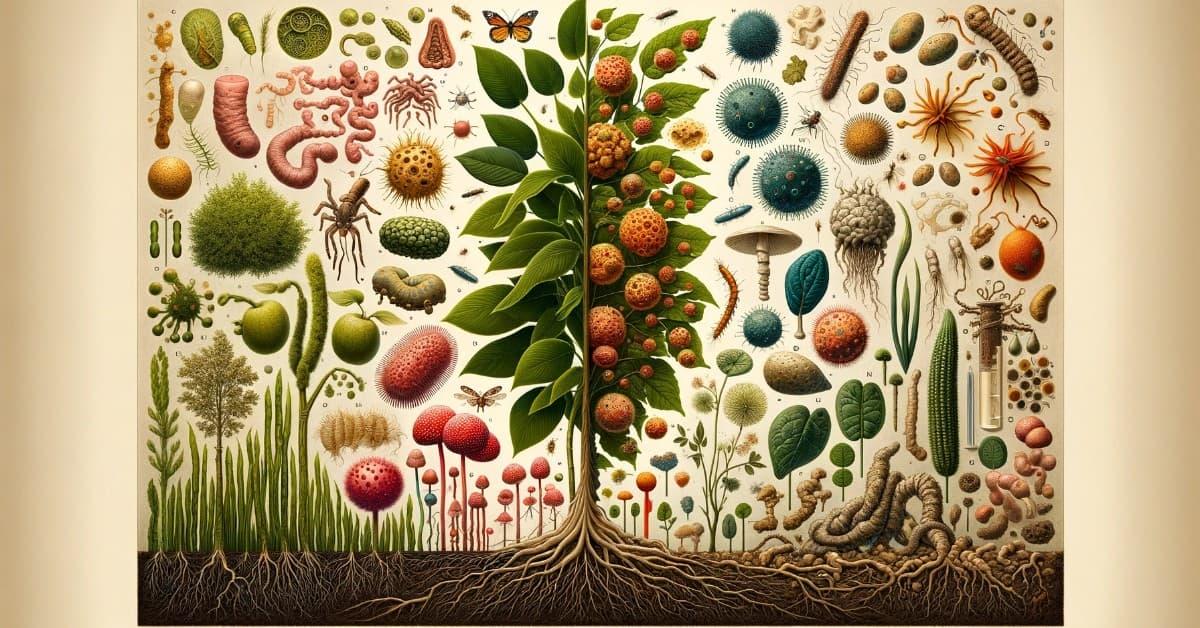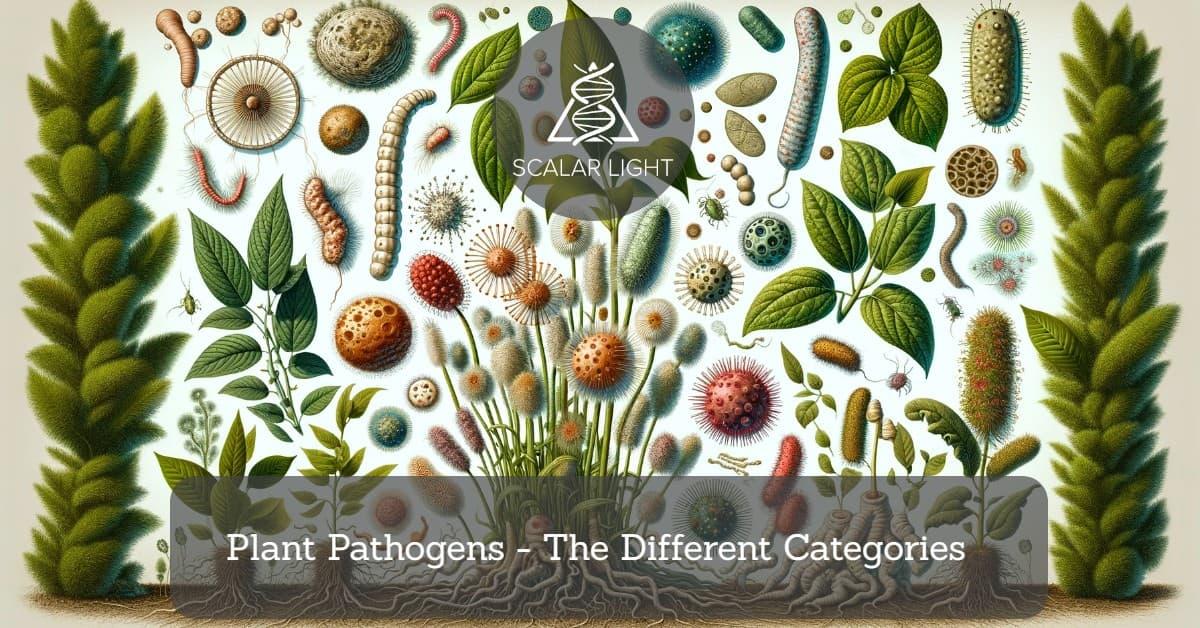Plant Pathogens - The Different Categories
Classification of Plant Pathogens
Biotic and Abiotic Plant Pathogens

At the first signs of deterioration in a crop, the less experienced farmer may become alarmed and try to get a generalist pesticide to use indiscriminately on his plantation. On many occasions, we blame the lack of vigor, changes in color, dwarfism, etc., on a biotic agent, when in reality, the cause of all their ills lies in an abiotic factor.
Therefore, the first major classification of plant pathogens is between biotic and abiotic. Within the abiotic are all environmental factors, such as temperature, light, wind, humidity, soil type, and quality, atmospheric pressure, etc. Each plant has a tolerance to each of these and a range within which it can carry out all its vital functions. Outside of these values, however, the health of the plant will be compromised, which may lead to the development of secondary diseases that take advantage of these circumstances.
However, most of the plant pathogens that cause plant diseases are living organisms and viruses (which are not actually alive but which we will keep in this category). There are thousands of living things that are capable of causing disease, either directly or indirectly, to almost every group of living things on the planet. Among them, we will talk about those that are specialized in attacking plants:
Fungi – Fungi are very common plant pathogens, causing diseases that farmers are more than used to. They have a body structure that forms filaments known as hyphae, which are capable of penetrating cells to absorb nutrients. Examples of fungal diseases are rust, root rot, some wilts, powdery mildew, downy mildew, powdery mildew, black mold, etc.
Bacteria – Bacteria are among the microorganisms that successively colonize plants as they mature. Large populations of bacteria become visible as aggregates in liquid media, as biofilms on plants, slimy suspensions clogging plant vessels, or as colonies in plates or Petri dishes in the laboratory. Populations of 106 CFU (Colony Forming Units/milliliter) or higher are generally required for bacteria to function as plant pathogens, causing infectious diseases. Bacteria as plant pathogens can cause serious and economically damaging diseases, ranging from spotting, mosaic, pustules on leaves and fruits, or malodorous rotting of tubers to death of plants.
Viruses – All viruses are obligate parasites that depend on their hosts for reproduction. And the diseases that these plant pathogens cause are difficult to diagnose because, even when caused by the same virus, symptomatology varies depending on virus-host interaction and environmental conditions. Crop response to infection can range from asymptomatic to severe disease-causing plant death. Symptoms are often inconspicuous and can easily be mistaken for nutrient deficiencies or herbicide damage. Viruses affect different parts of the plant, such as leaves, shoots, flowers, and fruits. The most common symptoms caused by viruses include dwarfing, mosaic, mottling, necrosis, chlorosis, and deformation.
Nematodes – Nematodes are a group of microscopic worms that live in the soil and attack the roots or aerial parts of most crops. They often cause such serious damage that it is impossible to maintain economically viable agriculture without the use of some form of nematological control. These plant pathogens live in the aqueous film in the labyrinth of soil micro tunnels and within tissue of the plant. All have a form of oral stylet or harpoon, which allows them to pierce the host cell wall and inject enzymes that partially digest the host cell contents before the nematode sucks them into its digestive system. Most of the damage that nematodes cause to plants is related in some way to the feeding process, as it decreases the ability of the roots to uptake and transport nutrients to the rest of the plant.
Protozoa – Algae and protozoa are not common plant pathogens. However, in recent years a number of diseases have been discovered that appear, with a reasonable degree of certainty, to be caused by organisms belonging to the genera Cephaleuros (algae) and Phytomonas (flagellates). It is surprising that this is the case with flagellates, but even more so with algae, since the genus, Cephaleuros, is a green alga and, therefore, autotrophic. However, studies seem to confirm that they cause considerable damage.
Parasitic Plants – These are plants that obtain some or all of the nutrients they need for their development from another plant. They are characterized by having a modified root, known as a haustorium, which penetrates the host plant and connects it to its xylem (lignified plant tissue that conducts sap and sustains the plant), phloem (conductive tissue responsible for the transport of organic and inorganic nutrients), or both. This causes a nutrient deficit in the host plant, and that’s why they are called plant pathogens.
Animals – There are many groups of animals that are potential plant pathogens. Mammals such as rodents and moles feed on plants and affect the roots with their galleries. Insects cause the most damage as they are very abundant and can cause plant-feeding pests. There are also snails and worms that can damage crops.

Tom Paladino
CEO - scalarlight.com
Tom Paladino is a researcher and humanitarian seeking to make a difference in the world by providing people with the education and tools to restore optimal health, and by helping enhance their quality of life. Read More
IMPORTANT NOTICE
All Scalar Light programs exclusively transmit scalar light upon the photographs of people, animals, plants and objects. Only the photographs of people, animals, plants and objects receive the scalar light transmission of energy. Scalar Light has NEVER been administered on an in-person basis. Furthermore, scalar light is an unrecognized energy dimension that has not been accepted by conventional science.
Scalar Light honors the medical community and encourages everyone to likewise respect and honor the advice of qualified medical and wellness professionals. Additionally, Scalar Light honors the scientific community and encourages everyone to likewise respect and honor the advice of qualified scientists and researchers.
The Scalar Light administration of scalar light upon photographs of people, animals, plants and objects has not been evaluated by the US Food and Drug Administration and / or any other Governmental derivatives thereof, known or unknown. Furthermore, the Scalar Light administration of scalar light upon photographs of people, animals, plants and objects has not been evaluated by the medical community nor the scientific community.
All Scalar Light sessions act exclusively upon the photographs of people, animals, plants and objects. Hence, all subject matter on the web site, SCALARLIGHT.COM is a direct and exclusive reference to the influence and action of Scalar Light upon these photographs of people, animals, plants and objects.
Recent Posts
I Haven’t had a Cold or the Flu in 7 Years
Scalar Light Testimony Following Tom's Interview on Coast to Coast
Scalar Light Overall Well-being Testimony
Scalar Light Disassembles the Herpes Virus
Herpes Testimonial Following Scalar Light Sessions
Scalar Energy Vs Parasites - Testimony
Increased Sleep, Better Digestion, Feeling of Lightness - Scalar Light Testimony
Scalar Light Digestive Enzyme Program Testimony
Nikola Tesla Quote About Non-Physical Phenomena
Scalar Light Identifies the Cancer Signature Embedded on a Photograph and Negates that Disease





